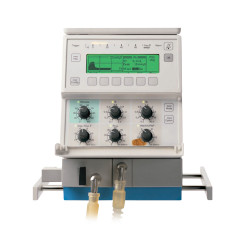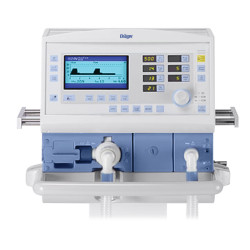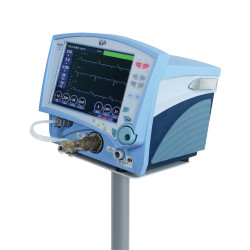Drager Evita 4 Ventilator

Drager Evita 4 Ventilator
0 item is in your cart. View cart now
All product and company names are trademarks of their respective holders. Use of them does not imply any affiliation with or endorsement or sponsorship by them.
Details
The Dräger Evita 4 is a ventilator for every patient population. The Evita 4 was designed to meet the demanding requirements of the ICU environment by improving the interactions between patient, ventilator and clinician. The functional touch screen continually provides the clinician information on ventilator settings, patient measurements and advanced trending capabilities which enhances the operation of the device. Unique features and modalities such as AutoFlow™ and APRV are standard on all Evita 4 ventilators.
One ventilator for every patient population
Neonatal, pediatric, adult – Evita 4 can be used to ventilate any patient category, reducing the amount of staff training required and ensuring greater resource flexibility.
The neonatal option, NeoFlow™, offers flow measurement at the Y-piece for precise volume and leak monitoring with accurate, responsive triggering to patient effort.
Intuitive user interface
Configurable trends, loops, measured values, curves and logbook are displayed on the full-color screen for a complete customized overview of the ventilation therapy. The user-friendly display shows only the active control elements to ensure immediate recognition of the required settings. The robust touch screen combines highly flexible operation with direct access to rotary knobs and keys.
Excellent weaning performance
PCV+/ BIPAPTM*, the universal mode for ventilation and weaning, gives a patient the freedom to breathe spontaneously at any time, reducing the need for sedation and invasiveness of ventilation to optimize the patient's ability to wean off the ventilator. Automatic Tube Compensation (ATC™) gives a patient the feeling of virtual extubation by eliminating the work involved in breathing through an endotracheal tube, improving the weaning process.
Conventional and mask ventilation
Mask ventilation can complement the weaning process by reducing the reintubation rate or even preventing intubation in the first place. The fact that Evita 4 offers the alternative of mask ventilation (NIV) means you only need one device for conventional and non-invasive ventilation.
Upgradeability
Evita 4 is based on a concept of innovative continuity. The device's modular design ensures upgradeability and upward compatibility while the user interface and sensors, for example, are based on the continuity principle to guarantee a high degree of familiarity.
A record of innovation
The Evita 4 story has been marked by a series of advances in ventilation therapy, ATC was introduced in 1997 to achieve virtual extubation, NeoFlow in 1998 for neonatal ventilation, and NIV in 2001 to make mask and conventional ventilation possible from a single device.
Safe investment
Even the first Evita 4 machines can be upgraded to include all the features of the latest models – clear evidence that Evita 4 is a good investment.
Basic research
Dräger Medical still invests a significant proportion of its human and financial resources in basic research – because we know this is a vital prerequisite for innovation and will continue to be so in the future.
Specifications
Physical Weight & Dimensions
- Height: 11.4 inches (290 cm)
- Width: 20.9 inches (530 cm)
- Depth: 17.7 inches (450 cm)
- Weight: Approx. 27 kg (60 lbs.)
- Diagonal screen size: 6.5" TFT LCD color display
Ventilation Settings
- Ventilation mode:
- IPPV, IPPVAssist (CMV, CMVAssist)
- SIMV, SIMVASB (SIMV, SIMV/Psupp)
- MMV, MMVASB (MMV, MMV/Psupp)
- BIPAP1), BIPAP1)ASB, BIPAP1)Assist (PCV+, PCV+/Psupp, PCV+Assist)
- CPAP, CPAPASB (CPAP, CPAP/Psupp)
- APRV (optional)
- ILV (optional)
- Enhancements
- AutoFlow™ – Automatic adaptation of inspiratory flow in volume controlled modes
- ATC™ – Automatic Tube Compensation (optional)
- IV - Mask Ventilation (optional)
- Ventilation frequency (f): 0 to 100 /min, 0 to150 /min (Neonatal)
- Inspiration time (Tinsp): 0.1 to 10 s
- Tidal volume (VT) (BTPS):
- 0.1 to 2.0 L (Adult)
- 0.02 to 0.3 L (Pediatric)
- 0.003 to 0.1 L (Neonatal)
- Inspiratory flow:
- 6 to 120 L/min (Adult)
- 6 to 30 L/min (Pediatric and Neonatal)
- Inspiratory pressure: 0 to 80 mbar (cmH2O)
- PEEP / intermittent PEEP: 0 to 35 mbar (cmH2O)
- Pressureassist (PASB) (Psupp): 0 to 80 mbar (cmH2O)
- Rise time for inspiratory pressure: 0 to 2 s
- O2 concentration: 21 to 100 Vol.%
- Multi-sense Trigger Criteria: Internal automatic pressure trigger, Flow, Volume (Flow adjustable 0.3 to 15 L/min)
Measured Values Displayed
- Airway pressure: Peak pressure, plateau pressure, mean pressure, PEEP, min. pressure (0 to 99 mbar/cmH2O)
- Minute volume (MV), (BTPS): MV, MVspont, MVleak (0 to 99 L/min)
- Tidal volume (VT), (BTPS): Inspired VT, expired VT, VTASB (VTPS) (0 to 3999 mL)
- Breathing frequency (f): ftotal, fspon, fmand. (0 to 300/bpm)
- O2 concentration: (FiO2) Inspired O2 concentration (15 to 100 Vol.%)
- Lung mechanics:
- Resistance ((0.0 to 600 mbar/L/s)(cmH2O/L/s)
- Compliance ((0.0 to 300 mL/mbar)(mL/cmH2O)
- Breathing gas temperature: 18°to 51°C
- Waveforms: Airway pressure-time, flow-time, volume-time, ...
- Trends (optional): FiO2, MV, VT, f, PEEPi, R, C, etCO2, ...
- Loops (optional): Paw-V, V-Flow, Flow-Paw, ...
- Capnography (etCO2) (optional): 0 to 100 mmHg
- CO2 production (VCO2): 0 to 999 mL/min, STPD
- Serial dead space Vds: 0 to 999 mL, BTPS
- Dead space ventilation (Vds/VT): 0 to 99%
- O2 saturation: SpO2, pulse
Alarms / Monitoring
- Airway pressure: High/Low
- Expired minute volume: High/Low
- Tidal volume: High
- Apnea alarm time: 5 to 60 s
- Spontaneous breath frequency: High
- Inspired O2 concentration: High/Low
- Breathing gas temperature: High
- SpO2 pulse (optional): High/Low
- etCO2 (optional): High/Low
Performance Data
- Max. flow for pressure support and spontaneous breathing: 180 L/min (adult), 60 L/min (pediatric)
- Valve response time: ≤ 5 ms
- Control principle: Time cycled, volume constant, pressure-controlled
- Safety relief valve: 100 mbar (cmH2O)
- Leakage compensation
- Hose system compensation
- Outlet for pneumatic nebulizer
Operating Data
- Mains power connection: 100 to 240 V, 50/60 Hz, 10 to 30 V DC (optional)
- Power consumption: Approx. 125 W
- Gas supply operating pressure: O2, air: 2.7 to 6 bar / 39 to 87 PSI
Machine Outputs
- Digital output: Output and reception via an RS 232 C interface
- Digital output: Output for independant lung ventilation (ILV)
- Digital output (optional): For output and reception via two RS 232 C interfaces
- Analog output (optional): For analog output of two measured values




